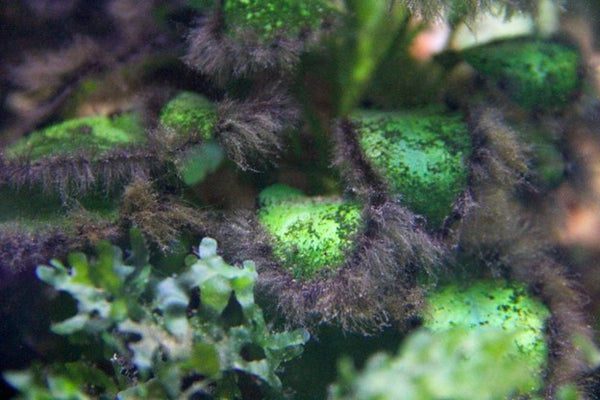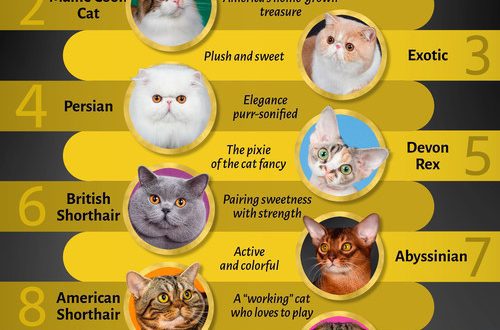
Blackbeard in the aquarium: what these algae look like and how to get rid of them with peroxide and other means
The appearance of a harmful algae called “black beard” is one of the most annoying and serious problems for aquarium owners. Dark patina and fine hairs dot all surfaces: from walls and soil to decor and algae, and significantly spoil the appearance of the entire ecosystem. How to get rid of the black beard in the aquarium?
Contents
What is a black beard and what does it look like
Blackbeard is an algae that spreads rapidly in your artificial pond, covering underwater surfaces in a continuous dark carpet. Also known as compsopogon (Compsopogon coeruleus), Black Brush Algae (BBA) or acid algae. It should not be confused with the red beard (Red Brush Algae) or Vietnamese – with external similarities, these are two completely different plants.
The black beard grows rapidly throughout the plant and is difficult to get rid of.
BBA belongs to the group of red algae. And although the natural color of the bushes varies from dark green to dark gray and even deep black, after a short exposure to alcohol, they acquire a pronounced reddish tint.
The fact that a pest has appeared in the aquarium is evidenced by small dark-colored spots on the decorations or leaves of aquarium plants.. An adult compsopogon looks like a cluster of filaments about 1,5–2 cm long, hard and rough to the touch. For the external resemblance to the bristles, the plant got its unusual name.
Having approached the plants, dark brushes cover their stems and grow along the edge of the leaves and their tops. They breed intensively in areas with fast water movement and quickly become attached to the walls of the aquarium, the ground and decorations.
The most radical way to deal with the pest is the firing of scenery and soil. You can also simply “restart the aquarium” by removing all infected plants. But these methods require a lot of time and effort.
From a biological point of view, blackbeard is not a parasitic algae, but it obscures the leaves of aquarium plants, destroys their tissues and slows down development. Due to the rapid growth of BBA, they suffocate and die. Slow-growing plants such as ferns and anubias cause the most damage.
Algae frames the leaves of the plant and spoils their appearance.
Causes of appearance
A fluffy carpet of black beard covers a snag in an aquarium
Blackbeard can appear in any aquarium, but there are a number of factors that increase the risk of its occurrence and development. Let’s talk about these factors in more detail.
- Aquarium resettlement. Fish are a source of phosphates and nitrates, so loved by the blackbeard. Therefore, in overcrowded aquariums, this algae feels more comfortable.
- Burrowing fish. Large catfish and other burrowing fish often pick up turbidity from the surface of the ground. It becomes a favorable environment for the development of the pest.
- Refeeding the fish. If the fish are regularly overfed, a high concentration of organic matter is formed in the aquarium, which is a nutrient medium for growth.
- New plants. Along with new plants, unexpected guests can also get into the aquarium. To prevent this from happening, newcomers should be quarantined and only then moved to an artificial reservoir.
- Rare water changes. The less frequently there is a change of water in the aquarium, the higher the likelihood of a black beard.
- Weak filtration. With poor filtration, water is not sufficiently cleaned of organic residues and turbidity, which are a favorable environment for the appearance of algae.
- Physical wear of the lamps. Old fluorescent lamps gradually lose their former brightness. In dim light, algae develop especially intensively.
- Hard and acidic water. In water with high hardness and acidity, the bearded pest feels better than in water with normal indicators.
There is a great way to reduce the amount of organic matter in an aquarium – activated carbon in an external filter. Just put it inside and after a couple of days you will notice the result.
Ways to deal with black beard in the aquarium
If the alga does not want to voluntarily leave the conquered territory, they get rid of it with the help of household and special means.
household products
Peroxide
Three percent hydrogen peroxide is diluted with water in a ratio of 1:20. Pour into the aquarium gradually, adding a filter to the jet. After 30–60 minutes, change 30–50% of the water. Siphon the soil, removing organic remains of food and plants from it.
Vinegar
This method is only suitable for hard-leaved plants. Vinegar is diluted with water in a ratio of 1:35. The plant (except for the roots) is immersed in the resulting solution for 10-15 minutes, then it is washed well and returned to the aquarium. You can use apple cider vinegar instead of regular vinegar.
Маргацовка
A light pink solution of potassium permanganate is prepared and the plants are kept in it. Hard-leaved plants take a bath with potassium permanganate for an hour, soft and tender plants take about 30 minutes.
Furazolidone
All inhabitants are removed from the aquarium. Dissolve several tablets of furazolidone or furacilin and incubate for several days. Under the influence of drugs, the water may turn yellow.
Special Tools
Sidex (Johnson & Johnson)
Sidex is also an additional plant food and beneficial bacteria.
This universal medical solution is sold with an activator powder. The activator is thrown away, and the solution is added to the aquarium at the rate of 15–20 ml for every 100 liters of water. Duration of treatment – no more than 2 weeks.
Under the action of the drug, the water in the aquarium may become cloudy. This is how its effect on the flora and fauna of the micro-reservoir is manifested.
Algicide+CO2 (AquaYer)
Turn off the filter. After 10-15 minutes, the drug is added to the water at the rate of 10-15 ml for every 100 liters of water. With smooth movements, the beard is treated with medicine from a syringe. The leaves of nearby plants can get burned. For shrimp, the medicine is not dangerous.
Before using the drug, it is necessary to make sure at the minimum dosages that the fish will tolerate its presence.
Algafix (API)
This drug has proven to be an effective remedy. The drug is added at the rate of 1 ml per 38 liters of water once every 3 days. Treatment is carried out until the algae die.
The drug Algafix is detrimental to crustaceans, so it can only be used in an aquarium with fish.
Easy Carbo Easy Life
Increases the competitive power of plants against algae
In accordance with the manufacturer’s instructions, add 1-2 ml of solution per 50 liters of aquarium water daily. After a few days, bearded algae should change their color to whitish or pinkish. Once this has happened, the treatment is stopped.
Prevention of the appearance of a black beard
Algae covers any surface, including decorative stones and soil
Keeping the Aquarium Clean
Maintaining cleanliness is especially important to prevent pest infestation. This algae absorbs the remains of organic matter that settle on its villi. To prevent the growth of a black beard, you need to regularly remove organic sediment.
Water should be changed once a week, each time renewing 25-30% of the total volume. In a heavily neglected and clogged aquarium, the water is changed every day, after cleaning it with an ion-exchange filter. This method does not work immediately, but after 2-3 months the number of beards is significantly reduced.
Dying plants are fertile ground for the reproduction of bearded algae. They must be removed from the aquarium immediately.
Cleaner fish and snails
There are also environmentally friendly methods of dealing with black beard. They involve the use of herbivorous cleaner fish and snails.
Fishes
Harmful algae are eaten with pleasure by Ancistrus catfish, Siamese algae-eaters, Labeo, mollies and fish of the carp-tooth family. In about a week, they are able to completely clear the aquarium of uninvited guests.
In order for the inhabitants of the aquarium to quickly destroy the pest, they must be kept on a starvation diet. Other fish for the time of “treatment” should be deposited in a separate container.
For catfish, it is necessary to create artificial twilight for 40 minutes a day. During this time, the fish actively eat harmful weeds in the underwater garden.
ampoule snails
Ampoules cope with the pest as effectively as herbivorous fish. It is best to launch about a hundred small snails no larger than a match head. After the kids have completely coped with the task, they must be removed from the aquarium, otherwise they will begin to grow and eat everything green in their path.
Thus, the black beard is not a pest plant, but it does not bring benefits to the aquarium either. To avoid the appearance of a fluffy carpet on the walls, plants and soil, it is necessary to monitor the cleanliness of the home reservoir, clean its bottom, change the water in a timely manner, and prevent too dense settlement and overfeeding of the inhabitants.





